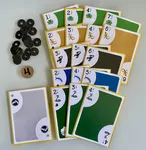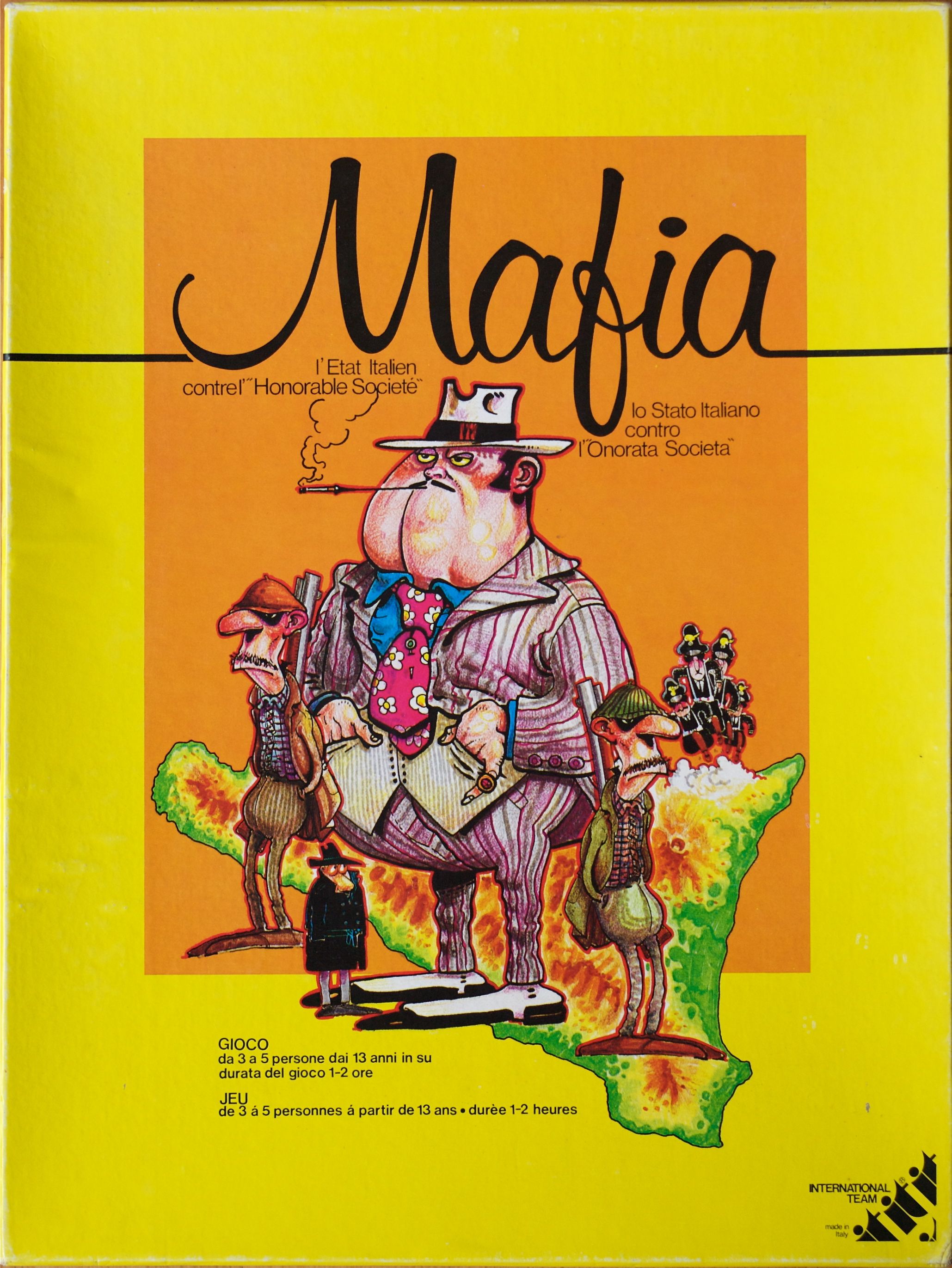Mafia (1981)
Tempo de Jogo: 120
Idade Mín.: 13
Jogadores: 3 - 5
Editora: International Team (I)
Designers: Marco Donadoni
Artistas: Massimo Petrini, Mauro Moretti
Mecânicas: Lose a Turn, Dice Rolling, Roll / Spin and Move, Events, Take That, Variable Set-up, Track Movement, Set Collection, Area Majority / Influence, Race
Idade Mín.: 13
Jogadores: 3 - 5
Editora: International Team (I)
Designers: Marco Donadoni
Artistas: Massimo Petrini, Mauro Moretti
Mecânicas: Lose a Turn, Dice Rolling, Roll / Spin and Move, Events, Take That, Variable Set-up, Track Movement, Set Collection, Area Majority / Influence, Race
Mostrar Descrição Mostrar Comentários Tendência de Preço
Four Mafia "Families," controlled by two to four players, vie for control of the island of Sicily. Each Family consists of a Boss and two gangs of young thugs (picciotti).
The mafioso are opposed by the forces of the Italian State who are controlled by an additional player (except under the four-player rules, where the players share responsibility for moving the State's counters). The State player controls the Prefetto (Prefect), three Carabinieri (military police) units, and a secret-service (SISDE) agent. The State has also established some static roadblocks around the island which can snare careless mafioso. Through their combined efforts, the forces of the State seek to arrest as many Bosses and picciotti as they can.
Two decks of cards are used to reflect events stemming from the influence of mafia allies in the United States and support for the Prefetto from the Italian continent. A third card deck represents the evidence the secret-service agent can gather to establish grounds for the Prefetto to arrest Bosses.
But the justice system is weak. Detainees and arrestees will be released without warning. Shootouts erupt across the island. Innocent diners can face repeated attacks at their favorite ristorante. The violence is unending, with ambushes and assassinations seeming to be as common as the leaves on the olive trees. However, there is no player-elimination element, or even permanent elimination of units. Replacements will always arrive from the continent, although that will take a variable amount of time.
The playing board is a track of 26 loosely-defined spaces running around the perimeter of the island of Sicily, and through the center, in a sort of a B-shaped pattern. The board includes three significant Sicilian cities (Palermo, Catania, and Enna) which can serve as headquarters for the Mafia Families. Units move by a roll of the dice in a clockwise fashion, using the combined total of the dice to move one unit, or the individual numbers shown on the dice to move two units.
The Families are in a race to be the first to control four spaces on the board, but the State can prevail if it imprisons enough Bosses and picciotti to remediate the plague of criminal violence.
Mafia is a straightforward game with an unusual setting. It aroused some discussion in Italian newspapers when it first came out. The game approaches its deadly serious subject with a sarcastic tone, and somewhat sanitized violence, for a strategic and thematic gaming experience.
The mafioso are opposed by the forces of the Italian State who are controlled by an additional player (except under the four-player rules, where the players share responsibility for moving the State's counters). The State player controls the Prefetto (Prefect), three Carabinieri (military police) units, and a secret-service (SISDE) agent. The State has also established some static roadblocks around the island which can snare careless mafioso. Through their combined efforts, the forces of the State seek to arrest as many Bosses and picciotti as they can.
Two decks of cards are used to reflect events stemming from the influence of mafia allies in the United States and support for the Prefetto from the Italian continent. A third card deck represents the evidence the secret-service agent can gather to establish grounds for the Prefetto to arrest Bosses.
But the justice system is weak. Detainees and arrestees will be released without warning. Shootouts erupt across the island. Innocent diners can face repeated attacks at their favorite ristorante. The violence is unending, with ambushes and assassinations seeming to be as common as the leaves on the olive trees. However, there is no player-elimination element, or even permanent elimination of units. Replacements will always arrive from the continent, although that will take a variable amount of time.
The playing board is a track of 26 loosely-defined spaces running around the perimeter of the island of Sicily, and through the center, in a sort of a B-shaped pattern. The board includes three significant Sicilian cities (Palermo, Catania, and Enna) which can serve as headquarters for the Mafia Families. Units move by a roll of the dice in a clockwise fashion, using the combined total of the dice to move one unit, or the individual numbers shown on the dice to move two units.
The Families are in a race to be the first to control four spaces on the board, but the State can prevail if it imprisons enough Bosses and picciotti to remediate the plague of criminal violence.
Mafia is a straightforward game with an unusual setting. It aroused some discussion in Italian newspapers when it first came out. The game approaches its deadly serious subject with a sarcastic tone, and somewhat sanitized violence, for a strategic and thematic gaming experience.
Atualmente não temos dados de preço para este jogo.
Este jogo não está sendo negociado no mercado atualmente:
Este jogo não está listado no mercado atualmente. Se você quer vender o seu, adicione-o ao mercado.
Mercado
O jogo também foi publicado com estes nomes:
Mafia
Jogos Relacionados
ag.gameitem.lastUpdated: 2025-05-19 03:21:04.949
















